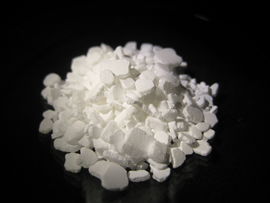Calcium chloride
 Anhydrous calcium chloride
| |
| Names | |
|---|---|
| IUPAC name
Calcium chloride
| |
| Other names
Calcium(II) chloride
Calcium dichloride E509 | |
| Properties | |
| CaCl2 | |
| Appearance | White hygroscopic solid |
| Odor | Odorless |
| Density | 2.15 g/cm3 (anhydrous) 2.24 g/cm3 (monohydrate) 1.85 g/cm3 (dihydrate) 1.83 g/cm3 (tetrahydrate) 1.71 g/cm3 (hexahydrate) |
| Melting point | 775 °C (1,427 °F; 1,048 K) (anhydrous) |
| Boiling point | 1,935 °C (3,515 °F; 2,208 K) |
| Anhydrous 74.5 g/100 ml (20 °C) Hexahydrate 49.4 g/100 ml (−25 °C) 59.5 g/100 mL (0 °C) 65 g/100 ml (10 °C) 81.1 g/100 ml (25 °C) 102.2 g/100 ml (30.2 °C) α-Tetrahydrate 90.8 g/100 ml (20 °C) 114.4 g/100 ml (40 °C) 'Dihydrate 134.5 g/100 ml (60 °C) 152.4 g/100 ml (100 °C) | |
| Solubility | Soluble in glacial acetic acid, alcohols Insoluble in liq. ammonia, DMSO, ethyl acetate |
| Solubility in ethanol | 18.3 g/100 g (0 °C) 25.8 g/100 g (20 °C) 35.3 g/100 g (40 °C) 56.2 g/100 g (70 °C) |
| Solubility in methanol | 21.8 g/100 g (0 °C) 29.2 g/100 g (20 °C) 38.5 g/100 g (40 °C) |
| Solubility in acetone | 0.01 g/100 g (20 °C) |
| Solubility in pyridine | 1.66 g/100 g |
| Acidity (pKa) | 8–9 (anhydrous) 6.5–8.0 (hexahydrate) |
| Thermochemistry | |
| Std molar
entropy (S |
108.4 J·mol-1·K-1 |
| Std enthalpy of
formation (ΔfH |
−795.42 kJ/mol (anhydrous) −1110.98 kJ/mol (monohydrate) −1403.98 kJ/mol (dihydrate) −2009.99 kJ/mol (tetrahydrate) −2608.01 kJ/mol (hexahydrate) |
| Hazards | |
| Safety data sheet | Sigma-Aldrich |
| Flash point | Non-flammable |
| Lethal dose or concentration (LD, LC): | |
| LD50 (Median dose)
|
1,000 mg/kg (rats, oral) |
| Related compounds | |
| Related compounds
|
Magnesium chloride Strontium chloride Barium chloride |
| Except where otherwise noted, data are given for materials in their standard state (at 25 °C [77 °F], 100 kPa). | |
| Infobox references | |
Calcium chloride (CaCl2) is a salt of calcium and chlorine. It's mainly used in amateur chemistry as a desiccant, because it is extremely hygroscopic and doesn't (significantly) decompose when heated to dryness.
Contents
[hide]Properties
Chemical
Calcium chloride serves as a source of calcium ions for reactions. Because calcium carbonate and sulfate are more or less insoluble, calcium chloride can be used to produce any metal chloride by introduction of a soluble sulfate or carbonate to its solutions.
- CaCl2 + MSO4 → MCl + CaSO4
Molten calcium chloride can be electrolyzed to yield calcium metal and chlorine gas:
- CaCl2(l) → Ca(s) + Cl2(g)
Physical
Calcium chloride is white, solid at room temperature. The anhydrous salt is very hygroscopic, it will quickly absorb water from the air to form a solution, a property known as deliquescence. Anhydrous calcium chloride must be stored in a very dry environment.
Availability
Calcium chloride can be cheaply purchased at hardware stores, stored in desiccator bags, that contain the anhydrous form. Some road salts are another source, and can be obtained in large quantities, though these products may also contain other chlorides or impurities. The anhydrous form can be produced by strongly heating the hydrate. Often, the dried calcium chloride will harden into a solid mass, that takes time to break, during which it will rapidly absorb water from air as it cools.
Preparation
Calcium chloride can be obtained by the reaction of calcium hydroxide or calcium carbonate and hydrochloric acid.
- Ca(OH)2 + 2 HCl → CaCl2 + 2 H2O
- CaCO3 + 2 HCl → CaCl2 + H2O + CO2
If these compounds are hard to come by, clean white limestone, seashells, or well-cleaned egg shells can be dissolved in hydrochloric acid, and the solute filtered. Calcium carbonate is then reprecipitated by addition of sodium carbonate or sodium bicarbonate, and finally dissolved in hydrochloric acid and filtered again. It is highly recommended that it is prepared strictly from a pure calcium salt though, as this process is time-consuming, costly, and fails to remove magnesium or iron impurities.
Projects
- Dry solvents
- Building a homemade desiccator
- Make a dry box
- Remove alcohols from esters (from the reaction product of esterifications)
- Electrolysis of molten, anhydrous calcium chloride to produce calcium metal
- Make ammonium chloride
Handling
Safety
Anhydrous calcium chloride can be an irritant due to its strong desiccating properties. Otherwise, it is only minimally toxic.
If large amounts of it are ingested, it may lead to vomiting, as large amounts of saline solution are irritating to the digestive track.
Storage
Calcium chloride should be stored in sealed containers or bags, as it is extremely hygroscopic. Zipper bags are also good to store anhydrous CaCl2.
Disposal
No special disposal is required. Calcium chloride is non-toxic to the environment, and it's even used as anti-icing during the winter. Avoid dumping large amounts of it into fields, as most plants tend to be chloride-sensitive.
References
Relevant Sciencemadness threads
- Calcium chloride recrystallization
- Making Calcium Chloride,and anhydrous
- OTC Calcium Chloride - Good for Drying
- Drying calcium chloride
- Drying CaCl2?
- Gah, I ruined my calcium chloride, how did it happen?
- calcium chloride from calcium carbonate (using a chloride salt)
- Why not use calcium chloride to supply calcium for nutrients?
- CaCl2 trap on vacuum pump?